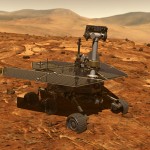NASA Budget Grounds Space Probes
 Robotic space exploration accounts for a tiny portion of NASA and the federal government's budgets. Yet, despite their merits these programs face deep cuts.
Robotic space exploration accounts for a tiny portion of NASA and the federal government's budgets. Yet, despite their merits these programs face deep cuts.
For decades, there was debate among space exploration proponents about the relative merits of manned versus unmanned missions. Enthusiasts of sending astronauts argued that manned missions captured the public imagination in a way that robotic probes never could, besides serving the grand purpose of building a human future in space.
Space probe proponents, including many scientists, emphasized the lower costs and far greater scientific payoff of robotic missions. They also noted the daunting difficulty of sending humans to Mars, let alone to the outer solar system where probes already travel.
The debate is now effectively over, and both sides have lost. A cherished notion long held by many probe advocates — that cutting back human space exploration would free up money for the robotic version — turns out to have little practical meaning.
NASA’s manned space program is under much-noted budget pressure. The space shuttle fleet is winding down to its final missions, plans for a human return to the moon have been scrapped and it is unclear what combination of governmental and private-sector activities will enable human access to orbit in the coming years, or how successful such efforts will be.
The robotic space program, meanwhile, also faces a future of fiscal squeezes, political uncertainty and diminished expectations. The Obama administration’s 2012 budget proposal foresees NASA’s annual planetary science funding dropping from its current $1.36 billion to less than $1.2 billion in 2016. The Obama 2011 budget had projected the figure to rise to $1.6 billion by 2016.
Congressional Republicans show little interest in defending robotic space exploration. Rather, their focus has been on cutting NASA’s budget overall (and, with particular zest, slashing Earth climate science) or, among NASA defenders (often based in states such as Texas and Florida with large NASA facilities), on preserving funding for manned space missions. Space probes don’t show up as vividly on the political radar.
The National Research Council, which advises the government on science policy, just released a report setting priorities in planetary exploration. The report raised the possibility that NASA may need to scrap one or both of its “flagship” missions: the Mars Astrobiology Explorer Cacher, (MAX-C), aimed at determining the Red Planet’s past or present suitability for life; and the Jupiter Europa Orbiter (JEO), focused on Jupiter’s moon Europa, which evidently has an ocean beneath its icy surface and thus too is a candidate for possible life.
Of course, times are tough all over and space probes cost money. Before taking the budget ax to robotic space exploration, though, consider how much it costs and what it achieves. Planetary science accounts for less than 10 percent of NASA’s budget, which in turn accounts for about 0.5 percent of the federal budget. For every $100 in federal spending, NASA gets about two quarters, and puts less than a nickel into space probes.
Until a few decades ago, humans knew little about the rest of the solar system. Now we have a wealth of data and images from Mercury to Neptune. The Voyager 1 probe, launched in 1977 for a tour of the outer planets, is still returning data from the edge of the solar system. Beginning with the Viking missions in 1976, we have been getting information directly from the surface of Mars, a place once relegated to science fiction. Probes have physically touched Jupiter’s atmosphere and Saturn’s moon Titan, among other celestial sites.
Gaining such knowledge and up-close pictures of our cosmic environs is unprecedented in history. Besides being enlightening, it provides practical benefits, such as technological advances (as when digital image processing for probes helped give rise to CAT scans) and insights into Earth science (as when Venus’ greenhouse effect raised questions about our own). Furthermore, robotic space probes are vital for building human capital. What kind of scientific and technological workforce would the U.S. have without the educational tools and interest in science generated by planetary exploration?
Don’t let space probes get crushed in Washington’s gravitational field.
Tweet